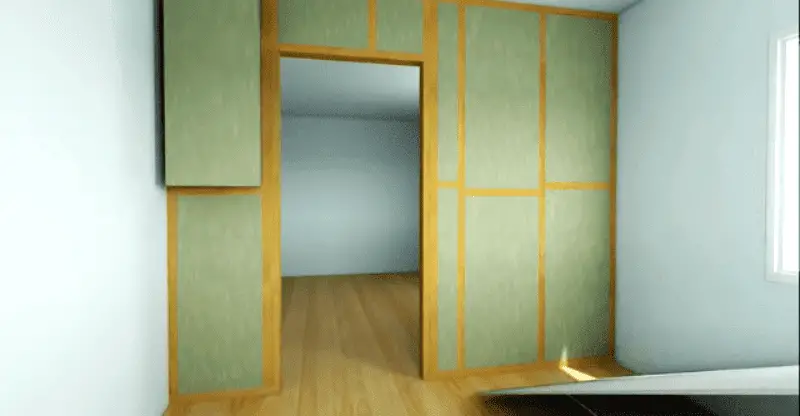How to Build a Temporary Wall in an Apartment
If you can’t afford to live with the layout of your house, a temporary wall might just be the solution you need.
Walls are always a design factor that is ignored. We want to concentrate on the colors that can be painted or on the shelves that can be placed on them.
Yet we think less frequently of the wall itself and of the space it makes. It wasn’t an unusual practice for renters to add temporary walls to their living areas, particularly in urban rental apartments.
A temporary wall is most commonly used to “split” one bedroom into two smaller bedrooms, however, a temporary wall also has several other potential applications.
Even so, building a full-length wall in an apartment is ill-advised and could well be in breach of your agreement.
To go around it, you may build a temporary wall, one which is fairly easy to build, and it can act as a temporary dividing wall in your smaller room.
For decades, tenants have relied on temporary walls to “make things work” in less-than-ideal conditions, splitting off living rooms to build separate bedrooms.
Homeowners, too, will benefit from temporary walls: building one helps you to determine if a proposed change is worth pursuing. And since a temporary wall doesn’t tie into a frame, it’s easy to remove, with minimal mess.
Temporary wall have quite a fair share of the advantages, but there are so many incentives that you’ll be interested in having one.
Even so, the thought could trouble you if you could somehow plan and manage this project on your own. Well, it all depends upon the extent of your carpentry skills; the whole project also depends on the available supplies and equipment.
If you really have what it takes to build a temporary wall, you’re going to be able to do it without few hassle and cost. If this wasn’t the case, it would be best if you hired an expert.
What Is A Temporary Wall?
The walls of the house are either load-bearing or non-load-bearing. Load-bearing walls are often situated on the exterior of a building, sometimes seen as inner walls. Non-load-bearing walls are often inner walls.
A temporary wall falls under the general category of non-carrying walls. It holds, or carries, no weight of every load from above; it bears only its own load.
A temporary wall is very much like the inner wall with the following changes:
- There are no electric wires or drainage tubing.
- It could be removed only with minimal, easily repairable harm to walls, floors, or ceilings.
- It’s founded on the ground, instead of tilted to the floor.
- The drywall can often be partly unfinished (no tape, no joint compound).
- It can be made using lightweight materials such as prefabricated panels or modular components, allowing for quick installation and removal without the need for extensive construction work.
Factors To Be Considered
You have to be ready by now to create a new temporary wall within your house. Before you start, there are a few considerations to keep in mind.
Lease Agreement
First of all, it is important that you cross-check your lease agreement and if there are any contractual obligations for temporary walls in your rental.
Even if the rental contract permits, you may still need to seek specific approval from your property manager or landlord for the same.
Please ensure that you need to set down in writing all the formalities that you are undertaking; it may be a document or an email), just so there is concrete evidence. The one thing you can prevent is the installation of a temporary wall that has never been approved.
Please notice that it could lead to lease terminations or no access to your deposits if you violate the contract terms, conditions, and provisions.
Safety Considerations
Due to its weight, a temporary wall can only be constructed on a stable foundation. Ceiling or steel beams cannot be adequate to support the weight of the temporary wall, depending on the scale of the wall. A concrete block base can support a temporary wall properly.
Decide On What You Need
When you consider the idea of constructing a temporary wall in your house, you will also need to decide not only about the layout of the wall, but also about other components.
For example, if your temporary wall is used to build an additional bedroom, you can need to calculate in space for a separate door/entrance. What about construction of a multi-purpose wall?
Some temporary walls can be installed with shelving so that you really can enjoy extra storage space in order to build a separate room for your rentals.
Take a bit of time to decide how lavish you have to get with your wall design before you move on.
Instructions
Step 1
Measure the gap first from floor to the ceiling with a measuring tape. You will also need to buy 2-by-4 wooden boards roughly 2 inches shorter than your measurement.
Step 2
Drill a 2-by-4 plank into your ceiling horizontally with wooden screw that will act as the top part of your wall. It’s known as top tile. You’re most likely to need to have a person to help.
Keep your partner on the ceiling when you’re drilling. The plank must be in the ceiling exactly below the floor, so you’re not simply boring into a drywall.
Be using a stud finder to help you identify joists if you wouldn’t know where they will be.
Step 3
Place a 2-by-4 plank on the ceiling vertically below the top plate. The plank must fit nicely between both the floor and the roof if you did take the measurements properly. Use a circular saw to shorten any planks as needed.
Step 4
Secure the vertical plank to the top plate by positioning the wooden screw in an angle near the top of the upper board. This procedure is referred as nailing the toe.
Step 5
Follow steps 3 and 4 and place the vertical planks, known as studs, each 2 feet till the framework of your temporary wall is completed.
Step 6
Drill bits of corkboard on either side of your temporary wall frame. Corkboard is a very lightweight material which is simple to change, making it suitable for a temporary wall. You can use drywall, even though it’s more permanent.
Tip
Add trim or shaping to the top or bottom of your temporary wall as well as paint it to fit your home.
If you’ve a thick carpet in your apartment, use the floor portion. The floor section is just like the top plate, only it’s on the floor and it’s not bolted to the ground. If you’re using a floor plate, you would have to cut an extra 2 inches off the vertical planks.
Warning
Don’t ever install electrical systems on a temporary wall. This is risky, particularly if you’re not an electrician, and that could eventually lead to fire.
Benefits Of Temporary Walls
There are several benefits to adding a temporary wall to your living area. If you’re like the majority of people living in a major city, you’re a tenant. This means that you cannot make permanent modifications to your living area.
A temporary wall gives the possibility to change the design of your apartment without making permanent structural modifications.
In several cases, a temporary wall could be easily dismissible without causing serious damage when you move out. When you have flat mates, building a temporary wall will give you and others more privacy.
For example, you might add a temporary wall between such a shared bathroom shower and a sink/vanity, that would allow one individual to shower private whereas another person would be using the rest of the bathroom to be get ready.
In certain situations, a temporary wall may also add an additional bedroom to your living area. This can be achieved by splitting a portion of the current common area or even splitting a large bedroom into two smaller bedrooms.
The end result is that more people are able to live comfortably within the apartments and get their own rooms.
So when you realize rising rental rates in major city markets, the opportunity to build your own two-bedroom apartment with a one-bedroom rental should save you (or your housemates) a huge amount of money.
Temporary Wall Options
Whenever it comes to building a temporary wall for your current living room, you could either create a wall yourself or pay a professional to help.
Building The wall By yourself
This choice is only suggested if you have any experience of working with carpentry and power tools. This approach is also great if you’re only attempting to build a wall and does not need additional equipment, like doors or shelving.
It’s also critical, again, that you can get written approval from your homeowner before you complete this project as it requires some drilling into joists.
You will need the following essential tools and equipment to construct your own wall:
- Wood screws
- Circular saw
- Power drill
- Stud finder
- Tape measure
- Corkboard sheets
- Two-by-fours
Hire A Professional
If you’re not really happy with the concept of constructing your own wall, think about hiring a specialist to do a job for you.
There are a variety of temporary wall construction companies that, once your lease is up, can not only create a temporary wall for you, but also dismantle it completely for free.
Special requests, such as adding windows, doors, and even soundproofing as required, may also be accommodated by these companies.
Most companies also provide temporary wall solutions which can be built without nails or screws, which could be easier to get the landlord on board.
They are known as non-pressurized wall and usually do not stretch entirely from floor to the ceiling, but it can still be useful in splitting space for an added bedroom or other reasons.
Conclusion
Temporary walls offer a flexible solution for creating additional spaces within existing structures. However, it’s crucial to consider and mitigate the associated risks.
Luckily, there are several DIY solutions for temporary walls that do not require any construction skills. If you have some extra time and want to save money, this is the perfect solution.
With the detailed and easy-to-follow instructions provided in this guide, you should now be able to build a temporary wall in your apartment.
FAQs
Temporary walls are typically made from wood, metal, or plastic materials. Prices vary depending on the material type and size of the wall. For example, a metal temporary wall can cost anywhere from $800 to $1200 per linear meter while a wooden temporary wall can start at $100 per linear meter. It is important to know that these prices do not include installation costs which can be costly depending on the type of temporary wall selected.
Yes! But, there are some things to keep in mind. When building a temporary wall, you need to figure out what the purpose of the wall is. Is it for storage? Is it so one person can have their own space? Once you’ve figured out what the wall is for, then you can determine if it’s better to build a permanent wall or a temporary one.
In the United States, there is not much legislation that governs what type of wall you can put up in your apartment. However, it is advised to consult your local zoning laws or a contractor before installing one.
To create an affordable temporary wall, use plywood sheets as the primary surface, anchored by 2×4 wooden studs, fastened with screws or brackets. To keep costs low, repurpose or borrow materials.
Recommended For You:
- How to Pick the Right Size Wall Mirror for Home
- 4 Easy Steps To Make Living Room a Bedroom
- 9 Things You Should Know Before Painting A Wall
- A Paint Guide: What is the Most Popular Color for Interior Walls
- Quick Ways To Freshen Up Your Home – 11 Tips To Get Started!
- 13 Modern Rustic Living Room Ideas on a Budget



